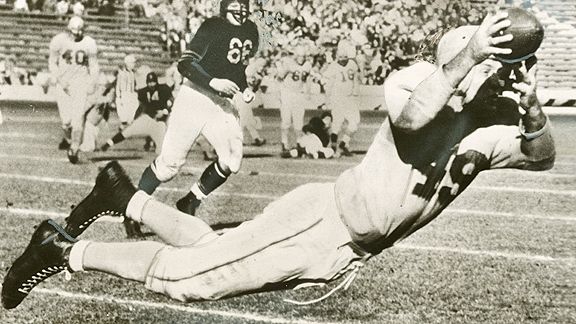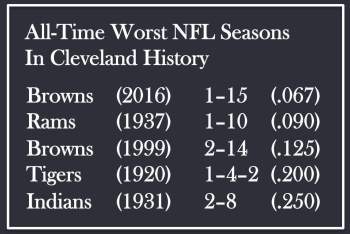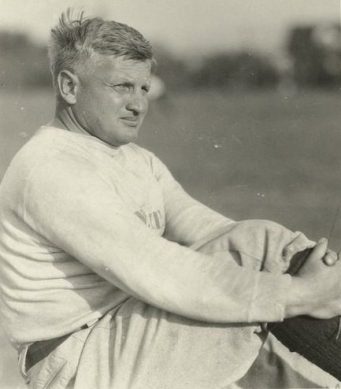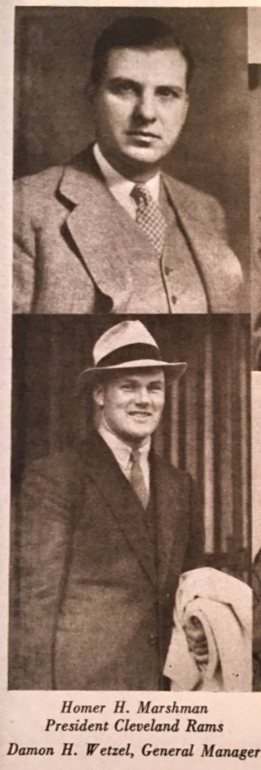
Joe DeLuca doesn’t just remember the Cleveland Rams, he remembers the Cleveland Rams vividly.
No surprise. When Joe was a wide-eyed kid, his dad and his uncles took him to many Rams games at League Park in the 1930s and ’40s—”back when it was not fashionable to watch pro football,” he says with a mix of pride and nostalgia.
For years he carried his memories of the Rams and Browns franchises’ early years in Cleveland with the same care and pride as the mail he delivered for 35 years as a postal employee. And this fall, Joe, an energetic sprite of a man, arrived with his daughter and grandson at my Cleveland Rams book talk at the Parma (OH) Public Library eager to share his first-hand accounts. Some of them he’d committed to paper. Others burst out of him like a quarterback cadence at the line of scrimmage.
More Than Seventy Years Ago …
Joe’s recollections, he says, have been “boiling in my gut for a long time.”
The Rams’ impact in Cleveland? “By the time 1945 came I was a die-hard Rams fan. We did not have much to cheer about in Cleveland since the 1920 Cleveland Indians won the World Series.”
The NFL championship game on December 16, 1945, claimed by the Rams over the Washington Redskins? “It was the coldest sporting event I have ever been to in my life. The next day I told my sixth-grade teacher that I went to the game. She said, ‘You are a real lunatic!'”
So it was worth it? “I was extremely, deliriously happy that day. The Cleveland Rams had finally put Cleveland on the professional sports map. Little did we know what was in store for us”—the debut of the even more successful Cleveland Browns the following year.

Joe recalls that in the gathering dusk of that mid-December day, exuberant fans pulled down a goal post on the Cleveland Stadium field. Later, “I saw a couple of fans carrying parts of the pipe through Public Square and I wondered for years how they got it home on a streetcar, or whose yard that pipe is rotting in today, not knowing what it is.”
Joe solved the mystery decades later when he came into contact with a fellow Rams fan named Bob Priest. Joe wondered aloud about those men in Public Square, and Priest told him it had been him and his brother, and that the police had confiscated the pipe and dropped the brothers in a jail cell for a few hours.
Joe now imagines the goalpost ended up in a police impound lot, anonymous and forgotten.
Rams, Browns; Reeves, Modell: History Repeats
Joe was not among the Cleveland fans whom most historical accounts say greeted the Rams’ departure with indifference. When Rams owner Daniel F. Reeves announced on January 12, 1946, that he was moving the champion Rams to Los Angeles, “upset  wasn’t the word” that described how Joe felt. “We hated Dan Reeves as much as people hated Art Modell for moving the Browns. There are not as many of us left today who remember that deep feeling. I personally have been through it twice.”
wasn’t the word” that described how Joe felt. “We hated Dan Reeves as much as people hated Art Modell for moving the Browns. There are not as many of us left today who remember that deep feeling. I personally have been through it twice.”
Joe recalls that he and his friends believed for some time that actress Jane Russell was all to blame for the team moving. “We thought she told her husband [Rams star quarterback] Bob Waterfield: ‘I don’t want to live in this hick town.’ We were so wrong!” The factors that moved the Rams were far more complex than the preferences of a rookie quarterback and his wife, but they did center primarily on Reeves’s desire to increase his revenue in a larger city with a larger stadium.
With the Rams gone, Joe at first resisted the fledgling Browns. “My friends were all excited about the Browns, and they asked me if I wanted to go with them to see the first game. I said ‘No.’ I was still pining for the Rams.”
Like nearly all pro football fans in Cleveland, however, Joe eventually placed his allegiance with the Browns. Yet the Rams never strayed far from his mind. He believes the immediate hold the Browns took on Cleveland was due not just to that unique time in history—servicemen were back from World War II, and the public was ready to distract itself with newly found leisure time and money—but also because “the Rams leaving town gave people a feeling of revenge for their loyalties being let down.”
How better to explain the fervor with which Clevelanders support the “new” Browns of today, even after the departure of a second franchise now called the Ravens? “History has a way of repeating itself,” Joe said.
Amid yet another dismal Browns campaign, DeLuca came to the library decked out in the Browns jersey of 1940s star running back Tommy Colella, his favorite all-time player. Colella was among an elite handful of players who donned uniforms of both the Cleveland Rams and the Cleveland Browns.
How fitting that Colella should be remembered with such fondness by one of the few remaining fans of both Cleveland teams.












